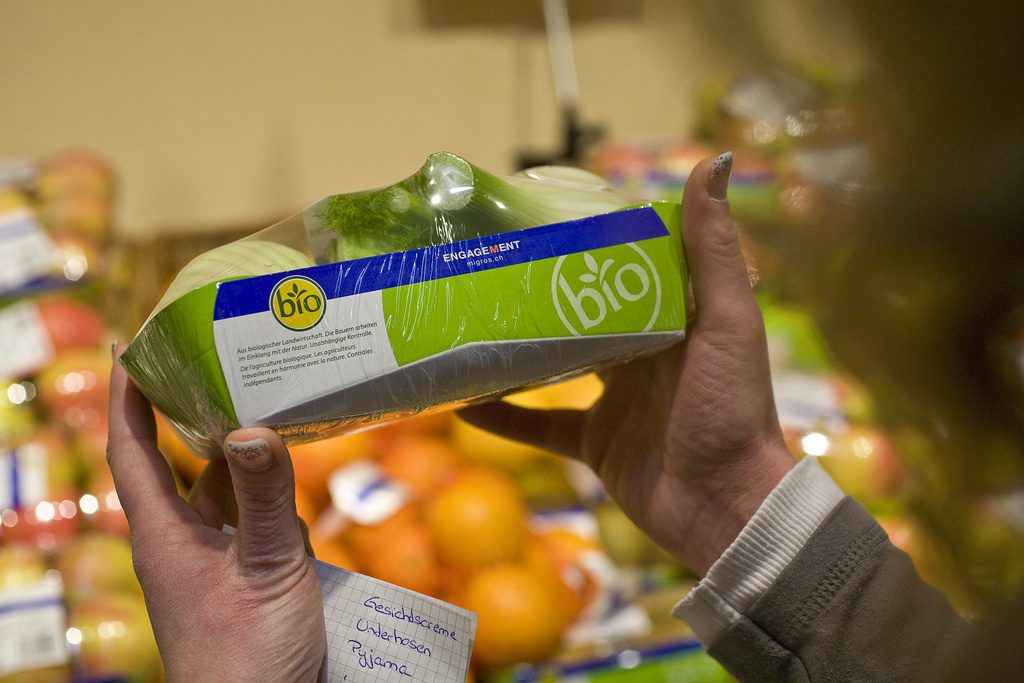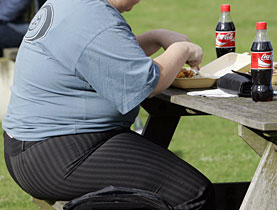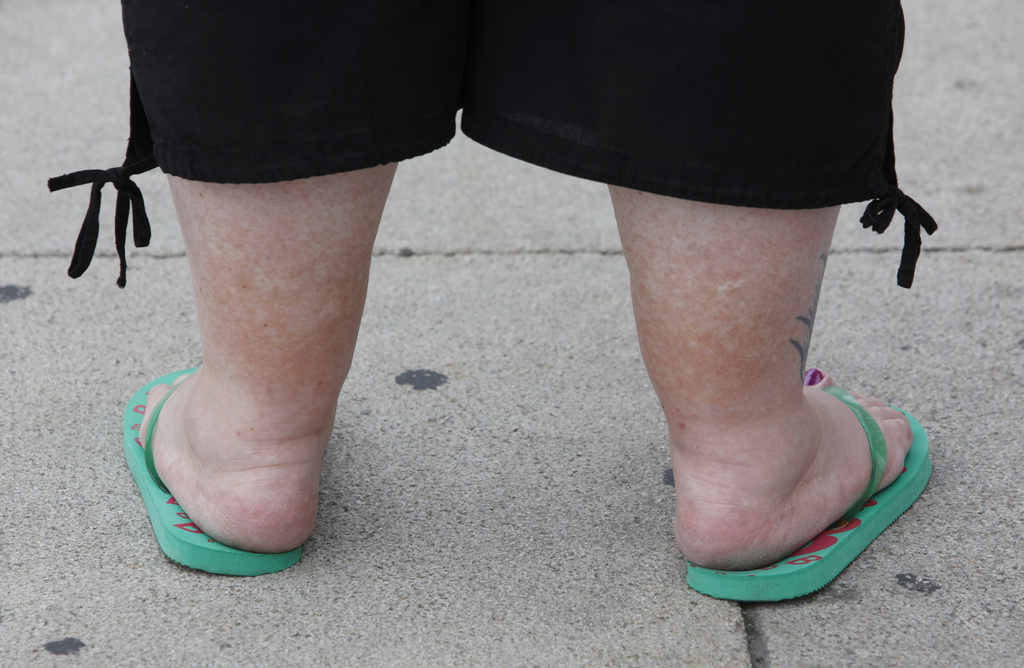Advocates push “traffic light” food labels

Findings that more than one in two Swiss residents are overweight are feeding a national debate about labelling of food products.
The Zurich-based Swiss obesity foundation SAPS (Schweizerische Adipositas-Stiftung) is calling for a “traffic light” rating system of bright red, amber and green labels.
The goal is to provide clear, easy-to-read warnings to consumers about food in supermarkets that may be dangerous to overweight people suffering from health problems.
The colours would be used to indicate levels of fat, saturated fat, salt and sugars, with red indicating high, amber moderate and green low levels.
“From our point of view, for people who are already too fat and who have to choose what they eat, this [system] would help,” Heinrich von Grünigen, chairman of SAPS, told swissinfo.ch.
The group has been lobbying for the change for some time. But the issue came into sharper focus following the findings of a study from the Federal Health Office indicating that 53 per cent of the country’s residents are overweight.
The results emerged from a detailed report about the overuse of salt released last week.
According to standards set by the World Health Organization, people are classified as overweight if their “body mass index” is 25 or more and obese if it is 30 or higher. (The index is calculated by dividing a person’s weight in kilograms by his height in metres squared.)
Suspect statistics
The latest Swiss figures came as a jolt because the percentage of overweight people in the country was previously gauged in 2007 at 37 per cent, according to a benchmark survey conducted every five years by the Health Office. That put Switzerland well below the average for European countries.
But von Grünigen, a former programme director for Swiss public radio DRS, said his organisation believes those earlier statistics seriously underestimated the extent of the problem.
“We always knew that the data was too low.” Switzerland is experiencing the same problem that is afflicting most countries in the world as a result of increasingly sedentary lifestyles and changing diets, with fast food becoming more prevalent, he said.
“It’s not very probable that the Swiss are very much lighter than the Germans, French and Italians living around them in the same region.”
The methodology used for the 2007 survey was questionable – and is not accepted by the World Health Organization – because it was based on phone interviews, von Grünigen said. People are less likely to tell the truth about their weight and in some cases may not even know it, he said.
The survey conducted for the salt study is based on 1,445 volunteers who were actually weighed and measured, offering a more reliable yardstick, he said. But even in that study “we believe that really heavy people or sick people did not participate”.
The new figures, all the same, provide the obesity foundation and other health critics with fresh ammunition to urge the authorities to take action. But not everyone is agreed on traffic light food labelling.
Disagreement
A colour-coded rating system was introduced in Britain several years ago by that country’s Food Standards Agency. However, the European parliament last year voted against the introduction of a similar compulsory system across the European Union.
Independent researchers and health organisations such as the British Medical Association claimed that using the three colours is the simplest way of informing consumers about how to make healthy choices when buying food. But food manufacturers mounted a multimillion-euro campaign to block the proposal.
The industry feared that some popular categories of food, such as cheese, would be unfairly tarred by a system with three colours.
Manufacturers argued that “traffic lights” could mislead consumers because they fail to take into account portion sizes and the consumption of a particular food in the context of an overall daily diet. And similar arguments have been made in Switzerland.
According to von Grünigen, bureaucrats say such a system does not sufficiently differentiate between the various kinds of foods. Honey, for example, is a natural product but it would warrant a red label because it is “100 per cent sugar”, he said.
But the obesity foundation believes that such a label is not meant to indicate that a product is forbidden but merely that consumers should pay attention to its contents. In rejecting the traffic light system the EU adopted a Guideline Daily Amounts (GDA) scheme, which expresses nutritional content for portions.
Critics point out that the GDA is too complicated, while studies have shown that less than five per cent of consumers bother to read detailed labels.
New label
However, Eva van Beek, spokeswoman for the Health Office, told swissinfo.ch that the department is currently working on a “new comprehensive food label” modelled on the one planned for the EU.
She acknowledged that the labelling process is complex because it has to take into account the requirements of a 56-page regulation on food labelling approved by lawmakers, which came into effect in 2006.
The regulation covers multiple issues beyond salt, sugar and fat content, such as ingredients, where the food originates from, whether it is certified organic and what its shelf life is.
Van Beek said it is important that food items in Switzerland are labelled “in the same way” as in the EU, given the ongoing trade between the two jurisdictions.
She was unable to confirm when the new labelling system would be introduced other than to say “it will be soon, not two or three years”.
The government plans to put the new labelling system on the Internet “to make it accessible for everyone”, she added.
The World Health Organization (WHO) defines overweight and obesity as abnormal or excessive fat accumulation that may impair health.
Weight problems are the fifth leading risk for global deaths, with at least 2.8 million adults dying each year from this cause. They are responsible for 41 per cent of diabetes cases and 23 per cent of ischaemic heart disease cases globally, according to the WHO. Additionally, between seven and 41 per cent of certain cancer cases are attributable to overweight and obesity.
Worldwide obesity has more than doubled since 1980, according to a WHO report this year. In 2008, 1.5 billion adults, 20 and older, were overweight. Of these over 200 million men and nearly 300 million women were obese. Nearly 43 million children under the age of five were overweight in 2010.
In Switzerland, a Federal Health Office study in 2009 estimated the disease-related costs of overweight and obesity had doubled to SFr5.75 billion ($6.26 billion) from SFr2.65 billion five years earlier. The latest government figures available from 2007 show 8.1 per cent of the population was obese, up from five per cent five years earlier.
The Swiss Obesity Foundation (SAPS) was founded in 1998 by doctors specialized in the treatment of obesity. The group offers a helpline, which operates daily from 9am to 5pm for people in Switzerland with weight problems: 044 251 54 13
The foundation’s chairman, Heinrich von Grünigen, has his own overweight challenge. He currently weighs more than 150 kilograms. “I am always struggling with my weight so I know what this issue is all about,” he said.

In compliance with the JTI standards
More: SWI swissinfo.ch certified by the Journalism Trust Initiative




You can find an overview of ongoing debates with our journalists here. Please join us!
If you want to start a conversation about a topic raised in this article or want to report factual errors, email us at english@swissinfo.ch.